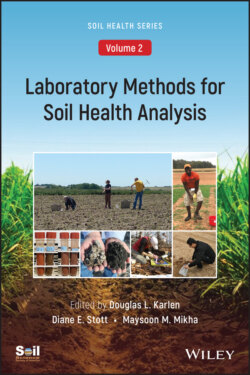Читать книгу Laboratory Methods for Soil Health Analysis, Volume 2 - Группа авторов - Страница 50
Measurement of SOC
ОглавлениеRecognizing there are multiple methods for measuring SOC, dry combustion, loss‐on‐ignition (LOI) (Schulte and Hopkins, 1996), and the Walkley–Black method (Nelson and Sommers, 1996) were evaluated for SOM are evaluated to examine the advantages and disadvantages of each method (Table 3.1). The traditional method for SOM analysis was wet oxidation in potassium dichromate (K2Cr2O7), better known as the Walkley–Black method. The potassium dichromate solution oxidizes soil organic material through a chemical reaction that generates heat when two volumes of sulfuric acid are mixed with one volume of dichromate. The remaining dichromate is titrated with ferrous sulfate, with the titer being inversely related to the amount of C present in the soil sample (Nelson and Sommers, 1996; Meersmans et al., 2009).
Although Walkley‐Black was the standard method for SOM analysis for decades, its use has diminished due to the high potential for environmental pollution during disposal and exposure of personnel to hazardous chemicals, such as potassium dichromate and sulfuric acid. In contrast, the LOI method is a simple, inexpensive method for SOM estimation that involves the combustion of samples at high temperatures and measuring weight loss after ignition. The ability of LOI to quantify SOM content has been considered reliable, but optimal heating temperatures and duration to maximize SOM combustion, while minimizing inorganic carbon combustion, are challenging to determine. Both of those variables can substantially affect LOI results (Salehi et al., 2011). Dry combustion using elemental carbon analyzers is now considered the gold standard for SOM measurement. This method is based on thermal oxidation of a soil sample at ~ 1000 °C and determining the quantity of CO2 produced by gas chromatography or infrared analysis. This method is considered the most accurate but is also the most expensive method for determining total carbon. Furthermore, to accurately measure SOC, inorganic carbon must be removed by pre‐treating samples with hydrochloric, phosphoric, or sulfuric acid before combustion. It is also important to point out that dry combustion measures SOC instead of SOM. Thus, a conversion factor is used to convert SOC into estimates of SOM. Historically, the most used conversion factor has been 1.724, which assumes organic matter is composed of 58% of carbon. However, recent studies have shown that this factor is too low for most soils. In a review of previously published data, the median conversion factor value was found to be 1.9 from empirical studies and 2 from more theoretical considerations. We concur that using a factor of 2, based on the assumption that organic matter is 50% carbon, will, in almost all cases, be more accurate than 1.724 (Pribyl, 2010).
Table 3.1 Advantages and disadvantages of the most common methods for measuring soil organic matter.
| Method | Advantages | Disadvantages |
|---|---|---|
| Walkley‐Black | Relatively simple, accurate, and quick | High environmental pollution potential, uses hazardous chemicals |
| Loss‐On‐Ignition | Simple, inexpensive, convenient | Heating temperature and time significantly affect accuracy. It has to be calibrated. |
| Dry combustion by elemental analyzer | Most accurate, quick | Elemental analyzers are expensive to purchase and maintain. |
For this chapter, we chose to present both the LOI and dry combustion methods since they are environmentally safe, simple, and the most widely used methods in commercial laboratories.
